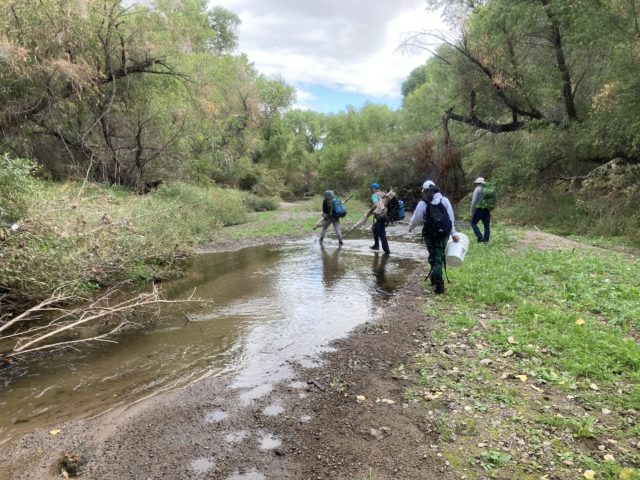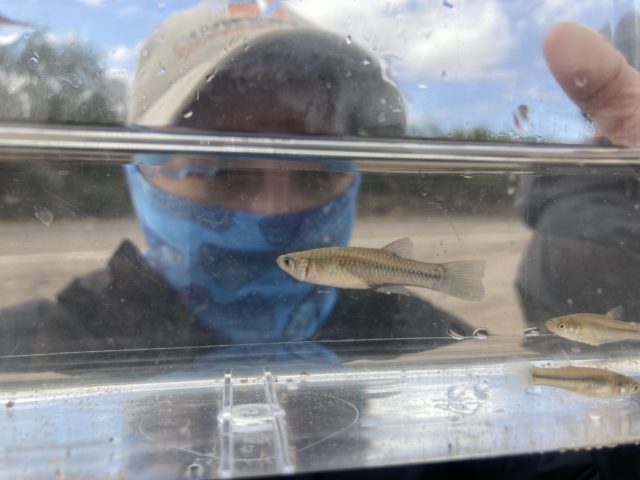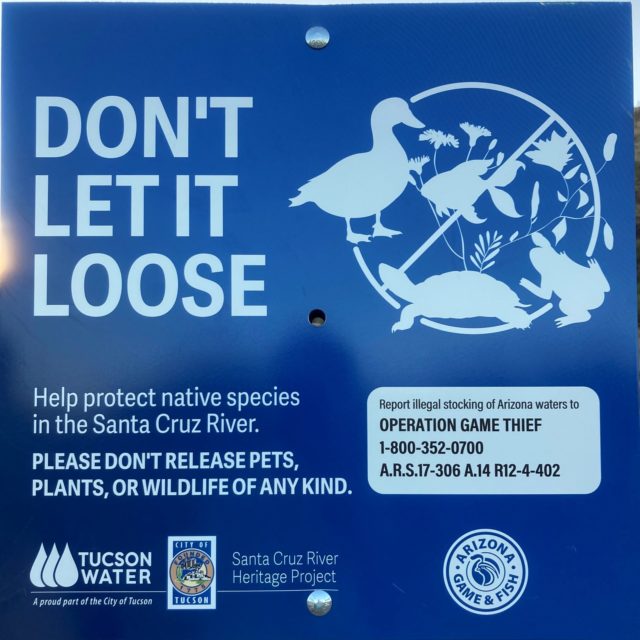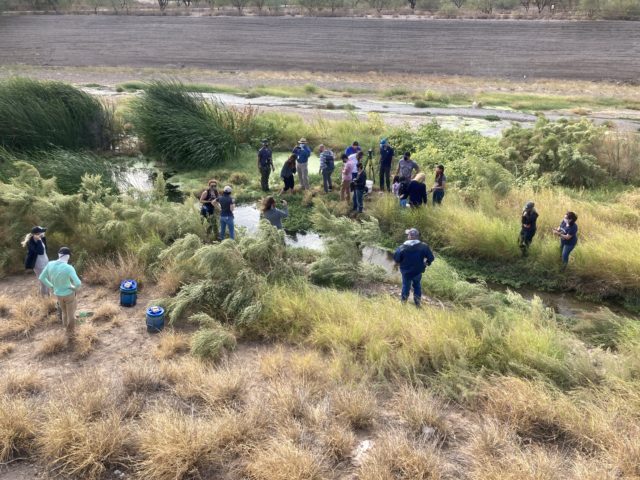
In 2015, we found about a dozen endangered Gila topminnow in the Santa Cruz River near Tubac. If you had told me then, that in 2020 I would help catch hundreds of the fish from this reach and move them to the newest flowing reach of the Santa Cruz in downtown Tucson, I would have thought “No way?!” But that’s just what happened.
On October 26, 2020 Arizona Game and Fish Department led a team of biologists to collect Gila topminnow from the river in Santa Cruz County and carefully transport the fish to a release point in the wetlands created by the Santa Cruz Heritage Project. The goal was to collect about 500 fish. We split up into three teams and dragged nets, called seines, through the river to catch fish.
Capturing the fish wasn’t too hard; we collected over 700 fish in about an hour. Our main challenge was that both Western mosquitofish and Gila topminnow are found in the river. These two small species from the Poeciliidae family are very similar looking, so much so, you need trained experts to identify them. Even when trained on the five or so distinguishing characteristics, it’s not so easy. The best way for the fish, and for biologists, is to place fish in a small viewing tank where they can be observed more easily. The experts each look and decide together if there is agreement on which fish is a topminnow. Anything suspected as possibly being a mosquitofish is removed.

Western mosquitofish are a non-native species from the Mississipi River basin that was introduced for mosquito control and are now widespread in our arid region’s rivers and streams. Like many non-natives, they compete with native species. And, though they are the same size, they are bullies and nip at the fins of the topminnow and even eat young ones.
Though the two species seem to be co-existing in the Santa Cruz near Nogales, mosquitofish are implicated in the disappearance of other populations of topminnow in the region. So, the team wanted to ensure only topminnow were being transported to the Heritage Project site, to give this reintroduction the best chance for success.
The experts each look and decide together if there is agreement on which fish is a topminnow.
Unfortunately, the hard work was not just carefully selecting the fish for reintroduction. Less than a week before the release date, University of Arizona professor Michael Bogan found mosquitofish in a pond just 1,000 feet downstream of the wetland where the topminnow would be released. It is likely they were introduced with good intentions but caused a significant risk to the success of the reintroduction.
After hours of careful searching and confirming the mosquitofish were isolated to this single location, Michael spent the long evenings and mornings leading up to the release trapping and removing as many mosquitofish as possible. Since then, signage has been installed along the river asking people to give native species a chance by not to putting any pets, wildlife, or plants into the river.

We’re still in the early phases of this Heritage Project experiment. It is an opportunity to support our river heritage as the release of water recharges the aquifer, and if we’re lucky, also create habitat for the native fish that once thrived here. Fortunately, the successful return of the topminnow has been seen in other parts of the river in northwest Tucson where they were rediscovered in 2017.
Afterall, it isn’t every day that we help a species move back to its historic home where it hadn’t been seen in over 70 years because the river had dried up.
On the late October morning when topminnow were collected for translocation to downtown Tucson, it was cold and rainy after months of unseasonably warm temperatures. We were wearing masks and keeping our distance while passing tank after tank of fish to each other, until we had collected enough positively identified topminnow to transport to the Heritage Project in downtown Tucson. The circumstances did little to dampen our spirits, however. Afterall, it isn’t every day that we help a species move back to its historic home where it hadn’t been seen in over 70 years because the river had dried up.

By afternoon the sun was shining, though a very cold and gusty wind had arrived ahead of an incoming cold front. We headed to release the fish in their new home. Given the pandemic, we limited the number of people from the collection team to do the honors. So, I stood up on the Loop path to watch from above. Mayor Romero helped celebrate this momentous event: as she gently emptied the first bucket of fish into the wetland, cheers and clapping erupted from the small, but excited group around her. By the end I was shivering in the wind, but my heart and soul were glowing. The Gila topminnow were finally back in their river home in downtown Tucson.
Learn more about how the reintroduction came to life: With Careful Planning, the Gila Topminnow Could Move Downtown. In spring 2020, Gila topminnow were observed near downtown Tucson reinvigorating discussions about how this native fish could be properly incorporated into the management of the Santa Cruz Heritage Project.
Blog Post By: Claire Zugmeyer, Ecologist
